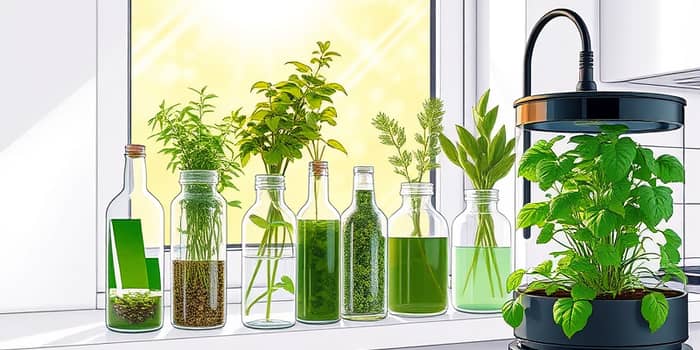Imagine stepping into your kitchen and snipping fresh basil and mint, all grown without a single grain of soil. Indoor soil-free herb gardens bring this dream to life.
Whether you live in a compact city apartment or simply crave a neat, organized garden, these methods deliver clean, mess-free, pest-free growing and year-round freshness.
Why Grow Herbs Indoors Without Soil?
Traditional soil gardening can be messy and space-intensive, but water-based techniques eliminate many common headaches. You won’t need bulky pots or worry about soggy floors. Instead, simple jars, vases, or hydroponic units keep everything neat.
By adopting hydroponics or water rooting, urban dwellers unlock access to herbs regardless of climate or season. This approach also offers minimal setup and low maintenance, making it ideal for beginners and seasoned gardeners alike.
Methods for Soil-Free Herb Cultivation
Two primary techniques dominate the soil-free herb world: water rooting and hydroponics. Both share the same principle—roots submerged in nutrient-infused water instead of soil.
- Water Rooting: Place 6-inch cuttings of soft-stemmed herbs into jars of filtered water, change water every few days, and wait 1–2 weeks for roots to appear.
- Hydroponics: Use deep water culture, nutrient film techniques, or drip irrigation systems paired with full-spectrum grow lights for precise control and higher yields.
Water rooting serves as a gentle introduction, requiring only clear or amber jars and occasional water changes. Hydroponic setups, though costlier upfront, deliver faster growth and harnessing the power of hydroponics transforms any windowsill into a productive mini-farm.
Best Herbs to Cultivate
- Basil
- Mint
- Oregano
- Rosemary
- Thyme
- Sage
- Chives
- Parsley
Herbs from the mint family often root quickly and thrive in water. Woody herbs like rosemary may take longer but reward you with robust flavor and fragrance.
Step-by-Step Guide to Indoor Herb Propagation
Follow this table to compare core steps and materials of each method, so you can choose the best fit for your space and budget.
Maintenance and Troubleshooting
- Algae Growth: Prevent by using opaque containers and shield roots from direct light.
- Nutrient Deficiency: Add balanced hydroponic solution every 1–2 weeks to avoid yellowing leaves.
- Light Shortage: Position near south-facing windows or install LED grow lights 12 inches above plants.
- Water Quality: Use filtered or dechlorinated water to keep pH stable and roots healthy.
Sustainability and Health Benefits
Hydroponic herbs can grow up to 50% faster than their soil counterparts, and systems use up to 90% less water. This translates to consistently fresh aromatic leaves at hand without waste or runoff.
Growing herbs indoors also reduces reliance on store-bought produce, cutting food miles and plastic packaging. You’ll nurture a micro-ecosystem that contributes to a truly sustainable home gardening practice and improved indoor air quality.
Conclusion
Embracing soil-free indoor herb gardening empowers you to harvest lush, flavorful greens year-round. From the first root hairs in water-rooted basil to flourishing hydroponic trays brimming with mint, you’ll experience the joy of fresh flavors and eco-friendly practices.
Start small with a single jar or dive into a full hydroponic setup—either way, you’ll witness how simple tools and water transform into a vibrant, productive herb garden. Your kitchen, health, and the planet will thank you.
References
- https://meadowlarkjournal.com/blog/growing-herbs-in-water
- https://savvygardening.com/growing-herbs-in-water/
- https://www.youtube.com/watch?v=W5oCcgGixR0
- https://www.gardenary.com/blog/how-to-start-an-herb-garden-indoors
- https://acornhorticulture.com/indoor-hydroponics-growing-plants-without-soil/
- https://www.solariverusa.com/blogs/solar-powered-hydroponics-aquaponics/top-5-benefits-of-outdoor-hydroponic-herb-gardens
- https://www.gardeners.com/how-to/herbs-indoors/8920.html
- https://www.pentair.com/en-us/water-softening-filtration/blog/herbs-you-can-grow-in-water-again-and-again.html










